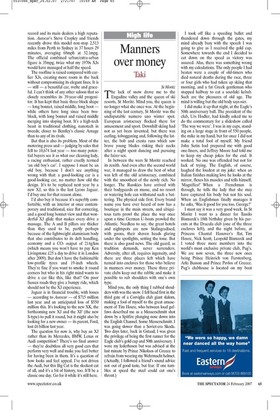Classic appeal
Alan Judd There's a fascinating new book about a man with a passion for a house which he lost and regained, brick by red Jacobean brick. The house was Thrumpton in Nottinghamshire, its devotee the late George Seymour, a complex man whose daughter, novelist and biographer Miranda Seymour, tells all with elegance and insight in In My Father's House (Simon & Schuster, £14.99). All' includes George's later passion for motorbikes and a couple of the men who rode them.
Whenever I met him, we kept to safer subjects — cars, mainly Jaguars. He had owned several and knew Sir William Lyons, who founded and ran the company. George's penultimate period Jaguar was a Mark 2 3.8 litre, the fastest (though not by much) and now the most collectable of that bloodline. Pulling off the M1 one day with overheating problems — not for the first time — he rang Sir William himself. Sir William sent his own car and driver to take George home while the Jaguar was recovered. Sir William's was a 3.4 and George asked the driver why the boss didn't have the top of his own range. Tor the reason you have just discovered, sir. He says that 3.4 litres is the optimum size for this engine and that boring it out to 3.8 increases the risk of what has happened to yours.'
They bored it out again, to 4.2, before launching the XJ6 in 1968. I was later told that the 4.2 was withdrawn from the German market because the hammering it received on the autobahns exposed the weakness George had discovered (it was replaced by the more powerful and beautifully balanced XJ12). The XJ design was the last Jaguar signed off by Sir William, who had the kind of eye for cars that some people have for horses. It came closest to his ideal, and his influence lives on in the contemporary XJ 2.7 TDVi Executive (£44,020) I drove this week.
This is the tweaked version of the V6 diesel that powers Discoveries. It is an engine that would not have worried Sir William, though he might have considered a diesel Jaguar an oxymoron. From outside it sounds like a slightly tappety petrol, from within you wouldn't know there is an engine. The 8.3 second 0-60mph time isn't going to leave everyone at the lights but you don't buy a big Jaguar for tyre-burning; anyway, effortless acceleration from 30mph nails you to your seat. Top speed is a believable 141mph and at 110mph (I understand) it feels like 70 in smaller cars.
Jaguar nowadays has a good reliability record and its main dealers a high reputation. Autocar's Steve Cropley and friends recently drove this model non-stop 2,513 miles from Perth to Sydney in 37 hours 29 minutes, averaging 68mph at 32.1mpg. The official combined urban/extra-urban figure is 35mpg, twice what my 1970s XJs would have managed at half the speed.
The roofline is raised compared with earlier XJs, creating more room in the back without compromising its elegant lines. It is — still — a beautiful car, svelte and graceful. I can't think of any other saloon that so closely resembles its 39-year-old progenitor. It has kept that basic three-block shape — long bonnet, raised middle, long boot — while others have long since been twoblock, with long bonnet and raised middle merging into sloping boot. It's a high-tech beast in traditional clothing, nanotech in tweeds; closer to Bentley's classic Arnage than to any of its rivals.
But that is also its problem. Most of the motoring press and — judging by sales that fell to 10,674 last year — too many potential buyers see it as what our cleaning lady, a racing enthusiast, rather cruelly termed 'an old boy's car'. I suppose I must be an old boy, because I don't see anything wrong with that: a good-looking car is a good-looking car, no matter how old the design. It's to be replaced next year by a new XJ, so this is the last Lyons Jaguar. I'd buy one for that reason alone.
I'd also buy it because it's superbly comfortable, with an interior at once contemporary and traditional, nice flat cornering, and a good long bonnet view and that wonderful XJ glide that makes every drive a massage. The A and B pillars are thicker than they used to be, partly perhaps because of the lightweight aluminium body that also contributes to its deft handling, economy and a CO2 output of 214g/km (which means you won't have to pay Ken Livingstone £25 a day to drive it in London after 2009). But don't have the fashionable low-profile tyres and 19-inch wheels. They're fine if you want to smoke it round corners but who in his right mind wants to drive a car like this, like that? On poor Sussex roads they give a bumpy ride, which should not be the XJ experience.
Jaguar is in financial trouble, with losses — according to Autocar — of $715 million last year and an anticipated loss of $550 million this. It's looking to the new XK, the forthcoming new XJ and the XF (the new S-type) to pull it round, but it might also be looking for a new owner — its parent, Ford, lost £6 billion last year.
The question for now is, why buy an XJ rather than its Mercedes, BMW, Lexus or Audi competition? There's no final answer — they're doubtless all very good cars that perform very well and make you feel better for having been in them. It's a question of how looks and feel appeal. I've not driven the Audi, but this Big Cat is the sleekest cat of all, and it's a bit of history, too. It'll be a classic one day. Go for it while it's still here.























































 Previous page
Previous page